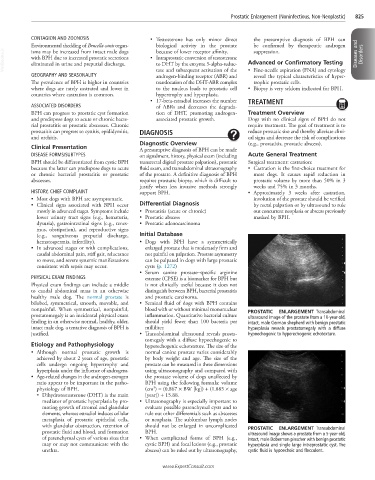Page 1639 - Cote clinical veterinary advisor dogs and cats 4th
P. 1639
Prostatic Enlargement (Noninfectious, Non-Neoplastic) 825
CONTAGION AND ZOONOSIS ■ Testosterone has only minor direct the presumptive diagnosis of BPH can
Environmental shedding of Brucella canis organ- biological activity in the prostate be confirmed by therapeutic androgen
VetBooks.ir with BPH due to increased prostatic secretions ■ Intraprostatic conversion of testosterone Advanced or Confirmatory Testing Diseases and Disorders
suppression.
because of lower receptor affinity.
isms may be increased from intact male dogs
to DHT by the enzyme 5-alpha-reduc-
eliminated in urine and preputial discharge.
GEOGRAPHY AND SEASONALITY tase and subsequent activation of the • Fine-needle aspiration (FNA) and cytology
androgen-binding receptor (ABR) and
reveal the typical characteristics of hyper-
The prevalence of BPH is higher in countries translocation of the DHT-ABR complex trophic prostatic cells.
where dogs are rarely castrated and lower in to the nucleus leads to prostatic cell • Biopsy is very seldom indicated for BPH.
countries where castration is common. hypertrophy and hyperplasia.
17-beta-estradiol increases the number
■ TREATMENT
ASSOCIATED DISORDERS of ABRs and decreases the degrada-
BPH can progress to prostatic cyst formation tion of DHT, promoting androgen- Treatment Overview
and predispose dogs to acute or chronic bacte- associated prostatic growth. Dogs with no clinical signs of BPH do not
rial prostatitis or prostatic abscesses. Chronic require treatment. The goal of treatment is to
prostatitis can progress to cystitis, epididymitis, DIAGNOSIS reduce prostatic size and thereby alleviate clini-
and orchitis. cal signs and decrease the risk of complications
Diagnostic Overview (e.g., prostatitis, prostatic abscess).
Clinical Presentation A presumptive diagnosis of BPH can be made
DISEASE FORMS/SUBTYPES on signalment, history, physical exam (including Acute General Treatment
BPH should be differentiated from cystic BPH transrectal digital prostate palpation), prostatic Surgical treatment: castration:
because the latter can predispose dogs to acute fluid exam, and transabdominal ultrasonography • Castration is the first-choice treatment for
or chronic bacterial prostatitis or prostatic of the prostate. A definitive diagnosis of BPH most dogs. It causes rapid reduction in
abscesses. requires prostatic biopsy, which is difficult to prostatic volume by more than 50% in 3
justify when less invasive methods strongly weeks and 75% in 3 months.
HISTORY, CHIEF COMPLAINT support BPH. • Approximately 3 weeks after castration,
• Most dogs with BPH are asymptomatic. involution of the prostate should be verified
• Clinical signs associated with BPH occur Differential Diagnosis by rectal palpation or by ultrasound to rule
mostly in advanced stages. Symptoms include • Prostatitis (acute or chronic) out concurrent neoplasia or abscess previously
lower urinary tract signs (e.g., hematuria, • Prostatic abscess masked by BPH.
dysuria), gastrointestinal signs (e.g., tenes- • Prostatic adenocarcinoma
mus, obstipation), and reproductive signs
(e.g., sanguineous preputial discharge, Initial Database
hematospermia, infertility). • Dogs with BPH have a symmetrically
• In advanced stages or with complications, enlarged prostate that is moderately firm and
caudal abdominal pain, stiff gait, reluctance not painful on palpation. Prostate asymmetry
to move, and severe systemic manifestations can be palpated in dogs with large prostatic
consistent with sepsis may occur. cysts (p. 1272)
• Serum canine prostate–specific arginine
PHYSICAL EXAM FINDINGS esterase (CPSE) is a biomarker for BPH but
Physical exam findings can include a middle is not clinically useful because it does not
to caudal abdominal mass in an otherwise distinguish between BPH, bacterial prostatitis
healthy male dog. The normal prostate is and prostatic carcinoma.
bilobed, symmetrical, smooth, movable, and • Seminal fluid of dogs with BPH contains
nonpainful. When symmetrical, nonpainful, blood with or without minimal mononuclear PROSTATIC ENLARGEMENT Transabdominal
prostatomegaly is an incidental physical exam inflammation. Quantitative bacterial culture ultrasound image of the prostate from a 10-year-old,
finding in an otherwise normal, healthy, older, should yield fewer than 100 bacteria per intact, male German shepherd with benign prostatic
intact male dog, a tentative diagnosis of BPH is milliliter. hyperplasia reveals prostatomegaly with a diffuse
justified. • Transabdominal ultrasound reveals prosta- hypoechogenic to hyperechogenic echotexture.
tomegaly with a diffuse hypoechogenic to
Etiology and Pathophysiology hyperechogenic echotexture. The size of the
• Although normal prostatic growth is normal canine prostate varies considerably
achieved by about 2 years of age, prostatic by body weight and age. The size of the
cells undergo ongoing hypertrophy and prostate can be measured in three dimensions
hyperplasia under the influence of androgens. using ultrasonography and compared with
• Age-related changes in the androgen-estrogen the prostate volume of dogs unaffected by
ratio appear to be important in the patho- BPH using the following formula: volume
3
physiology of BPH. (cm ) = (0.867 × BW [kg]) + (1.885 × age
○ Dihydrotestosterone (DHT) is the main [year]) + 15.88.
mediator of prostatic hyperplasia by pro- • Ultrasonography is especially important to
moting growth of stromal and glandular evaluate possible parenchymal cysts and to
elements, whereas estradiol induces cellular rule out other differentials such as abscesses
metaplasia of prostatic epithelial cells, or neoplasia. The sublumbar lymph nodes
with glandular obstruction, retention of should not be enlarged in uncomplicated PROSTATIC ENLARGEMENT Transabdominal
prostatic fluid and blood, and formation BPH. ultrasound image shows a prostate from a 5-year-old,
of parenchymal cysts of various sizes that • When complicated forms of BPH (e.g., intact, male Doberman pinscher with benign prostatic
may or may not communicate with the cystic BPH) and focal lesions (e.g., prostatic hyperplasia and single large intraprostatic cyst. The
urethra. abscess) can be ruled out by ultrasonography, cystic fluid is hypoechoic and flocculent.
www.ExpertConsult.com

